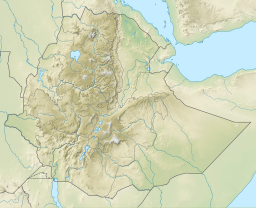| Era | |
|---|---|
  | |
| Coordinates | 13°41′35″N 39°46′00″E / 13.69306°N 39.76667°E / 13.69306; 39.76667 |
| Type | Freshwater artificial lake |
| Basin countries | Ethiopia |
| Surface area | 0.37 km (0.14 sq mi) |
| Water volume | 1.920000×10 |
| Settlements | Atsbi |
Era is a reservoir located in the Atsbi Wenberta woreda of the Tigray Region in Ethiopia. The earthen dam that holds the reservoir was built in 1997 by SAERT.
Dam characteristics
- Dam height: 16.73 metres
- Spillway width: 10 metres
Capacity
- Original capacity: 1 920 000 m³
- Dead storage: 480 000 m³
- Reservoir area: 37 ha
Irrigation
- Designed irrigated area: 100 ha
- Actual irrigated area in 2002: 95 ha
Environment
The catchment of the reservoir is 16 km large. The reservoir suffers from rapid siltation. Part of the water that could be used for irrigation is lost through seepage; the positive side-effect is that this contributes to groundwater recharge.
References
- De Wit, Joke (2003). Stuwmeren in Tigray (Noord-Ethiopië): kenmerken, sedimentatie en sediment-bronnen. Unpub. M.Sc. thesis. Department of Geography, K.U.Leuven.
- Nigussie Haregeweyn, and colleagues (2006). "Reservoirs in Tigray: characteristics and sediment deposition problems". Land Degradation and Development. 17: 211–230. doi:10.1002/ldr.698. S2CID 129834993.
- Vanmaercke, M. and colleagues (2019). "Sediment Yield and Reservoir Siltation in Tigray". Geo-trekking in Ethiopia's Tropical Mountains. GeoGuide. Cham (CH): Springer Nature. pp. 345–357. doi:10.1007/978-3-030-04955-3_23. ISBN 978-3-030-04954-6. S2CID 199112876.
- Nigussie Haregeweyn, and colleagues (2008). "Sediment yield variability in Northern Ethiopia: A quantitative analysis of its controlling factors". Catena. 75 (1): 65–76. Bibcode:2008Caten..75...65H. doi:10.1016/j.catena.2008.04.011.